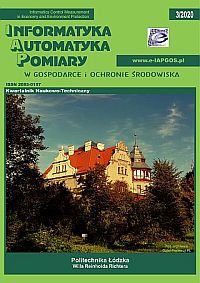INCREASING RADIATION RESISTANCE OF MEMORY DEVICES BASED ON AMORPHOUS SEMICONDUCTORS
Article Sidebar
Open full text
Issue Vol. 10 No. 3 (2020)
-
THE DIAGNOSTIC OF TWO-PHASE SEPARATION PROCESS USING DIGITAL IMAGE SEGMENTATION ALGORITHMS
Michał Łukiański, Radoslaw Wajman5-8
-
ANALYSES OF SKIN LESION AREAS AFTER THRESHOLDING
Magdalena Michalska9-12
-
THE INFLUENCE OF THE PRINCIPAL COMPONENT ANALYSIS OF TEXTURE FEATURES ON THE CLASSIFICATION QUALITY OF SPONGE TISSUE IMAGES
Róża Dzierżak13-16
-
SPATIAL PARAMETERS OF STATOGRAMS IN DIAGNOSING PATHOLOGIES OF THE HUMAN LOCOMOTOR SYSTEM
Sergii Pavlov, Yurii Bezsmertnyi, Stanislav Iaremyn, Halyna Bezsmertna17-21
-
INFOCOMMUNICATION TECHNOLOGIES FOR ASSESSMENT AND PREDICTION OF ENVIRONMENT IMPACT ON HUMAN HEALTH
Oksana Boyko, Nataliya Dorosh, Irena Yermakova, Oleh Dorosh, Żaklin Grądz22-25
-
USING BRAIN-COMPUTER INTERFACE TECHNOLOGY AS A CONTROLLER IN VIDEO GAMES
Błażej Zając, Szczepan Paszkiel26-31
-
PERFORMANCE COMPARISON OF MACHINE LEARNING ALGORITHMS FOR PREDICTIVE MAINTENANCE
Jakub Gęca32-35
-
SOLVING THE FAILING TRACK MARKER PROBLEM IN AUTOMATED GUIDED VEHICLE SYSTEMS – A CASE STUDY
Tomasz Lewowski36-43
-
BAPV SYSTEM MODELING FOR THE SINGLE-FAMILY HOUSE: A CASE STUDY
Ewelina Krawczak44-47
-
ANALYSIS OF HEAT TRANSFER IN BUILDING PARTITIONS WITH THE USE OF COMPUTATIONAL FLUID DYNAMICS TOOLS
Arkadiusz Urzędowski, Joanna Styczeń, Magdalena Paśnikowska-Łukaszuk48-51
-
SELECTED ASPECTS IN THE ANALYSIS OF THE COMBUSTION PROCESS USING WAVELET TRANSFORM
Żaklin Grądz52-55
-
MANAGEMENT OF POWER IN ASPECTS OF ENERGY PRODUCTION PRICES FOR FUEL ENERGY GENERATORS
Konrad Zuchora56-59
-
A REVIEW OF VOLTAGE CONTROL STRATEGIES FOR LOW-VOLTAGE NETWORKS WITH HIGH PENETRATION OF DISTRIBUTED GENERATION
Klara Janiga60-65
-
DISASSEMBLABLE VACUUM CHAMBER AS AN INNOVATIVE TEST STAND DESIGNED FOR RESEARCH ON IMPROVING THE OPERATIONAL PARAMETERS OF POWER SWITCHING APPARATUS
Michał Lech66-69
-
ELECTROMAGNETIC COMPATIBILITY TESTING OF ELECTRIC VEHICLES AND THEIR CHARGERS
Aleksander Chudy, Henryka Danuta Stryczewska70-73
-
FREQUENCY MODULATION APPROACH BASED ON SPLIT-RING RESONATOR LOADED BY VARACTOR DIODE
Dmytro Vovchuk, Serhii Haliuk, Pavlo Robulets, Leonid Politanskyi74-77
-
INCREASING RADIATION RESISTANCE OF MEMORY DEVICES BASED ON AMORPHOUS SEMICONDUCTORS
Vasyl Kychak, Ivan Slobodian, Victor Vovk78-81
-
TORQUE MEASURING CHANNELS: DYNAMIC AND STATIC METROLOGICAL CHARACTERISTICS
Vasyl Kukharchuk, Valerii Hraniak, Samoil Katsyv, Volodymyr Holodyuk82-85
-
EXPERIMENTAL STUDY OF NATURAL GAS HUMIDITY CONTROL DEVICE
Yosyp Bilynsky, Oksana Horodetska, Svitlana Sirenko, Dmytro Novytskyi86-90
-
ELLIPTIC-CURVE CRYPTOGRAPHY (ECC) AND ARGON2 ALGORITHM IN PHP USING OPENSSL AND SODIUM LIBRARIES
Mariusz Duka91-94
-
OPTIMIZATION IN VERY LARGE DATABASES BY PARTITIONING TABLES
Piotr Bednarczuk95-98
-
ANALISYS OF THE INFLUENCE OF GLUE JOINTS ON THE MEASUREMENT OF PHYSICAL PROPERTIES OF STRUCTURAL ELEMENTS USING FIBER BRAGG GRATING
Tomasz Zieliński, Łukasz Zychowicz99-102
Archives
-
Vol. 12 No. 4
2022-12-30 16
-
Vol. 12 No. 3
2022-09-30 15
-
Vol. 12 No. 2
2022-06-30 16
-
Vol. 12 No. 1
2022-03-31 9
-
Vol. 11 No. 4
2021-12-20 15
-
Vol. 11 No. 3
2021-09-30 10
-
Vol. 11 No. 2
2021-06-30 11
-
Vol. 11 No. 1
2021-03-31 14
-
Vol. 10 No. 4
2020-12-20 16
-
Vol. 10 No. 3
2020-09-30 22
-
Vol. 10 No. 2
2020-06-30 16
-
Vol. 10 No. 1
2020-03-30 19
-
Vol. 9 No. 4
2019-12-16 20
-
Vol. 9 No. 3
2019-09-26 20
-
Vol. 9 No. 2
2019-06-21 16
-
Vol. 9 No. 1
2019-03-03 13
-
Vol. 8 No. 4
2018-12-16 16
-
Vol. 8 No. 3
2018-09-25 16
-
Vol. 8 No. 2
2018-05-30 18
-
Vol. 8 No. 1
2018-02-28 18
Main Article Content
DOI
Authors
Abstract
A memory cell structure is proposed that uses a Schottky barrier thin film transistor based on an amorphous semiconductor as a junction element, and a chalcogenide glassy semiconductor film as a switching element. A physical storage cell model has been developed. The dependence of the transistor and memory cell parameters on the dose of neutron flux and γ - quanta was investigated. It is shown that when the dose of neutron irradiation is changed, the steepness of the drain-gate characteristic (DGC) decreases by 10% at a dose of the order of 1015 n/s, at the same time, the transfer coefficient of the bipolar n-p-n transistor decreases by 20% already at doses of 1013 n/s, indicating a significant increase in the radiation resistance of the proposed memory cell. In the case of irradiation with γ - quanta in the range up to 2.6 MRad, the steepness of the DGC of the proposed structure changes by only 10%. When used as an isolation element, a field-effect transistor with an insulated gate, the slope of the DGC is reduced by 50%. It is shown that the current of recording information of the proposed structure when changing the dose of γ - quantum flux to 2.6 MRad changes by about 10%, at the same time, in the case of using a field-effect transistor with an isolated cover, the information recording current changes by 50%. The study of the dependence of the gate current on the dose of γ – quanta is showed. When the radiation dose changes from 0 to 2.6 MRad, the gate current changes only by 10%, which indicates the high resistance of the proposed structure to the action of permeable radiation. Also, studies of the dependence of the conductivity of single-crystal semiconductors on the radiation dose ɣ by quanta and neutron flux show that a significant increase in the specific resistivity of AS occurs at doses 2-3 orders of magnitude larger than in the case of single-crystal n-type conductivity semiconductors.
Keywords:
Article Details
Abstract views: 391
License

This work is licensed under a Creative Commons Attribution-ShareAlike 4.0 International License.






